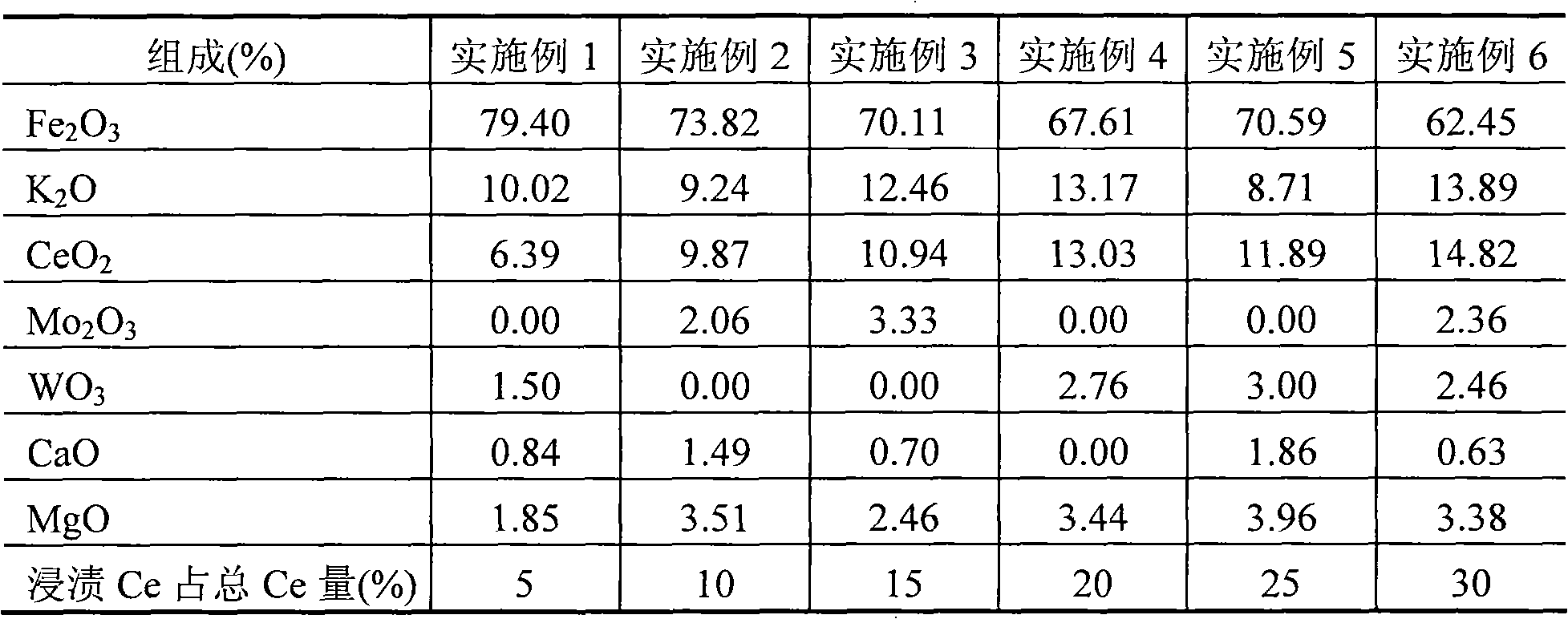Method for preparing styrene catalyst by ethyl benzene dehydrogenation
A catalyst technology for the dehydrogenation of ethylbenzene, which is applied in the direction of catalyst activation/preparation, chemical instruments and methods, metal/metal oxide/metal hydroxide catalysts, etc., and can solve the problems of low initial catalyst activity and long induction period , to achieve the effect of improving initial activity, increasing activity and good technical effect
- Summary
- Abstract
- Description
- Claims
- Application Information
AI Technical Summary
Problems solved by technology
Method used
Image
Examples
Embodiment 1
[0017] 261.0 grams of iron oxide red, 151.0 grams of iron oxide yellow, 70.0 grams of potassium carbonate, 74.1 grams of cerium nitrate, 8.2 grams of ammonium tungstate, 8.8 grams of magnesium oxide, 4.0 grams of calcium oxide, 4.0 grams of graphite, 10.6 grams of carboxymethyl cellulose Stir in a kneader for 1 hour, add deionized water, and stir for another half an hour, take out the extruded strips, extrude them into particles with a diameter of 3 mm and a length of 5-10 mm, put them in an oven, bake at 50°C for 2 hours, and bake at 100°C for 10 Hours, then placed in a muffle furnace, roasted at 800 ° C for 4 hours to obtain a semi-finished catalyst. Weigh 1.64 g of cerium nitrate and dissolve it in 55.0 ml of water, soak 200.0 g of semi-finished catalyst in this solution for 2 hours, then bake at 80°C for 12 hours, then bake at 350°C for 24 hours to obtain the finished catalyst.
[0018] 100 milliliters of finished catalysts are loaded into the reactor, under normal pressur...
Embodiment 2
[0020] 253.0 grams of iron oxide red, 100.0 grams of iron oxide yellow, 60.0 grams of potassium carbonate, 81.0 grams of cerium oxalate, 11.2 grams of ammonium molybdate, 15.5 grams of magnesium oxide, 11.8 grams of calcium carbonate, 2.0 grams of polystyrene microspheres, 16.5 grams of carboxylate Stir the methyl cellulose in a kneader for 1 hour, add deionized water, and stir for another half an hour, take out the extruded strips, extrude them into granules with a diameter of 3 mm and a length of 5-10 mm, put them in an oven, and bake at 50 ° C for 6 hours. Then it was placed in a muffle furnace and calcined at 650° C. for 12 hours to obtain a semi-finished catalyst. Weigh 3.84 g of cerium nitrate and dissolve it in 40.0 ml of water, soak 150.0 g of semi-finished catalyst in this solution for 10 hours, then bake at 120°C for 6 hours, then bake at 500°C for 6 hours to obtain the finished catalyst.
[0021] Activity evaluation was carried out according to the evaluation condit...
Embodiment 3
[0023] 213.0 grams of iron oxide red, 90.0 grams of iron oxide yellow, 73.0 grams of potassium carbonate, 76.5 grams of cerium oxalate, 16.3 grams of ammonium molybdate, 9.8 grams of magnesium oxide, 5.0 grams of calcium carbonate, 5.0 grams of hydroxyethyl cellulose, 20.3 grams of carboxylate Stir the methyl cellulose in a kneader for 1 hour, add deionized water, and stir for another half an hour, take out the extruded strips, extrude them into granules with a diameter of 3 mm and a length of 5-10 mm, put them in an oven, and bake at 50 ° C for 2 hours. Baked at 100°C for 10 hours, then placed in a muffle furnace, and fired at 1000°C for 0.5 hour to obtain a semi-finished catalyst. Weigh 6.32 grams of cerium nitrate and dissolve it in 40.0 milliliters of water, soak 150.0 grams of semi-finished catalyst in this solution for 16 hours, then bake at 130°C for 3 hours, then bake at 560°C for 5 hours to obtain the finished catalyst.
[0024] Activity evaluation was carried out acc...
PUM
| Property | Measurement | Unit |
|---|---|---|
| diameter | aaaaa | aaaaa |
Abstract
Description
Claims
Application Information
 Login to View More
Login to View More - R&D
- Intellectual Property
- Life Sciences
- Materials
- Tech Scout
- Unparalleled Data Quality
- Higher Quality Content
- 60% Fewer Hallucinations
Browse by: Latest US Patents, China's latest patents, Technical Efficacy Thesaurus, Application Domain, Technology Topic, Popular Technical Reports.
© 2025 PatSnap. All rights reserved.Legal|Privacy policy|Modern Slavery Act Transparency Statement|Sitemap|About US| Contact US: help@patsnap.com



